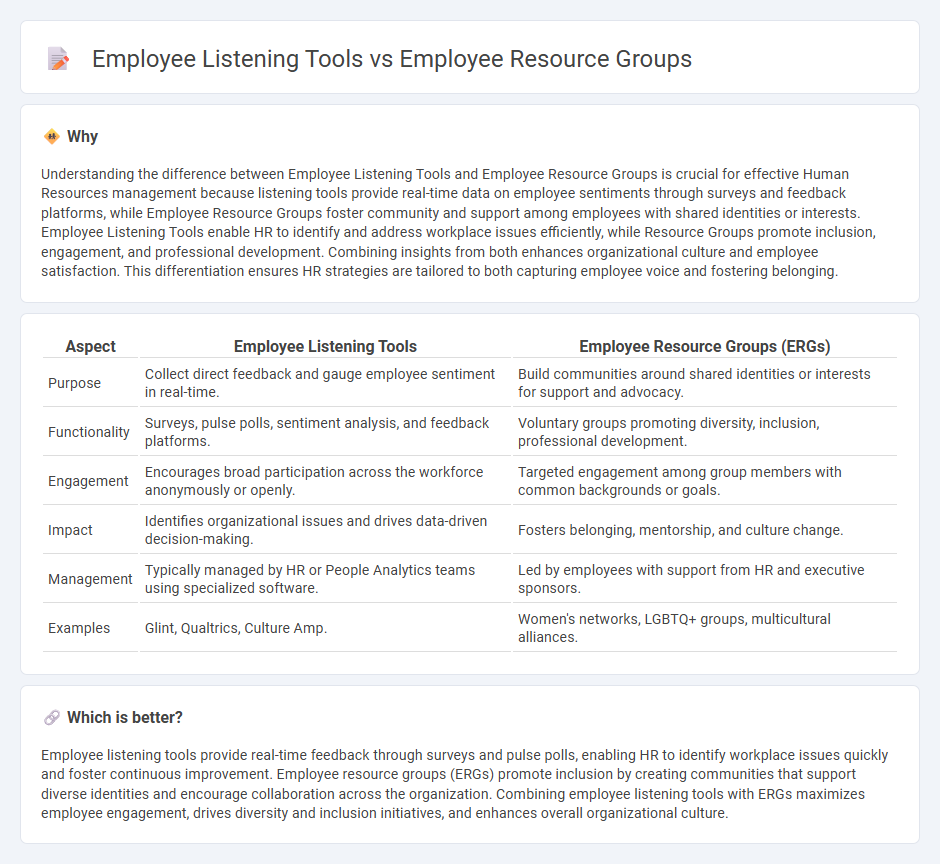
Employee listening tools utilize surveys, feedback platforms, and real-time analytics to capture workforce sentiment, driving data-informed decisions that enhance employee engagement and organizational culture. Employee Resource Groups (ERGs) foster community and inclusion by uniting employees around shared identities or interests, supporting diversity initiatives and promoting professional development. Explore how integrating these approaches can amplify employee voice and cultivate a thriving workplace environment.
Why it is important
Understanding the difference between Employee Listening Tools and Employee Resource Groups is crucial for effective Human Resources management because listening tools provide real-time data on employee sentiments through surveys and feedback platforms, while Employee Resource Groups foster community and support among employees with shared identities or interests. Employee Listening Tools enable HR to identify and address workplace issues efficiently, while Resource Groups promote inclusion, engagement, and professional development. Combining insights from both enhances organizational culture and employee satisfaction. This differentiation ensures HR strategies are tailored to both capturing employee voice and fostering belonging.
Comparison Table
| Aspect | Employee Listening Tools | Employee Resource Groups (ERGs) |
|---|---|---|
| Purpose | Collect direct feedback and gauge employee sentiment in real-time. | Build communities around shared identities or interests for support and advocacy. |
| Functionality | Surveys, pulse polls, sentiment analysis, and feedback platforms. | Voluntary groups promoting diversity, inclusion, professional development. |
| Engagement | Encourages broad participation across the workforce anonymously or openly. | Targeted engagement among group members with common backgrounds or goals. |
| Impact | Identifies organizational issues and drives data-driven decision-making. | Fosters belonging, mentorship, and culture change. |
| Management | Typically managed by HR or People Analytics teams using specialized software. | Led by employees with support from HR and executive sponsors. |
| Examples | Glint, Qualtrics, Culture Amp. | Women's networks, LGBTQ+ groups, multicultural alliances. |
Which is better?
Employee listening tools provide real-time feedback through surveys and pulse polls, enabling HR to identify workplace issues quickly and foster continuous improvement. Employee resource groups (ERGs) promote inclusion by creating communities that support diverse identities and encourage collaboration across the organization. Combining employee listening tools with ERGs maximizes employee engagement, drives diversity and inclusion initiatives, and enhances overall organizational culture.
Connection
Employee listening tools collect real-time feedback and insights that help identify workforce needs, which directly inform the formation and focus of Employee Resource Groups (ERGs). ERGs leverage this data to create targeted support networks, driving inclusion and engagement based on employees' expressed concerns and aspirations. The synergy between listening tools and ERGs enhances organizational culture by aligning resources with authentic employee experiences.
Key Terms
Diversity & Inclusion (Employee Resource Groups)
Employee Resource Groups (ERGs) foster diversity and inclusion by creating safe spaces where employees with shared identities or interests connect, collaborate, and advocate for equity within the workplace. ERGs drive cultural awareness, enhance employee engagement, and influence organizational policies through grassroots activism and peer support networks. Discover how ERGs can transform your company's D&I strategy and empower underrepresented voices.
Feedback Mechanisms (Employee Listening Tools)
Employee listening tools actively capture real-time feedback through surveys, pulse checks, and digital platforms, enabling organizations to identify workplace issues and employee sentiments promptly. Employee resource groups (ERGs) provide targeted support and foster community among specific employee demographics but may not offer comprehensive, continuous feedback across the organization. Explore how integrating employee listening tools can enhance your feedback mechanisms and drive meaningful organizational change.
Engagement (Both)
Employee resource groups (ERGs) foster engagement by creating inclusive communities that support diverse employee identities and promote collaboration, enhancing workplace culture. Employee listening tools capture real-time feedback and sentiment, enabling organizations to address concerns, improve policies, and increase overall employee satisfaction. Discover how integrating ERGs with advanced listening technologies can elevate engagement strategies and drive organizational success.
Source and External Links
Employee Resource Groups: Your Complete Guide - This guide from Indeed discusses the various types of Employee Resource Groups (ERGs), including diversity and inclusion, volunteer, affinity, and professional development groups.
Employee Resource Group - This Wikipedia article explains Employee Resource Groups as employee-led groups focused on support, career development, and personal development, often based on shared characteristics or life experiences.
10 Successful Examples of Employee Resource Groups - This article provides examples of successful ERGs from companies like Avison Young, King Games, and Microsoft, highlighting their roles in diversity, inclusion, and employee engagement.
 dowidth.com
dowidth.com